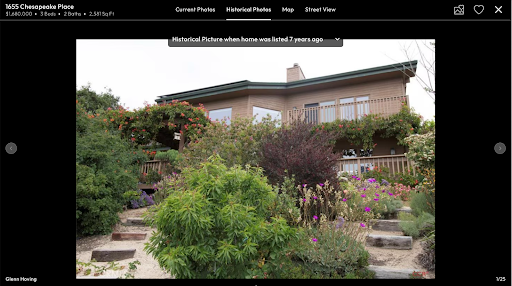When the National Association of REALTORS® amended its Internet Data Exchange (IDX) policy in 2012 to require MLSs to provide sold property data starting January 1, 2012, few could have anticipated how this decision would eventually reshape the consumer real estate experience. Fast forward to 2025, and we’re seeing the long-term implications of that policy change play out in innovative ways.
Homes.com recently launched a great new feature displaying historical property photos alongside current listings, becoming the first major portal to offer consumers this comprehensive view of a property’s visual history. While industry observers initially raised questions about innovation, copyright concerns, and potential violations of trust, the reality is far more nuanced—and reveals important strategic considerations for MLS leadership.
New listing

Old Listing

The Real Story Behind the Feature
According to Andy Woolley, VP of Industry Relations at Homes.com, the historical photos are not the result of new data partnerships or innovative technology. Instead, they represent a creative use of data that MLSs have been providing all along. This is 100% compliant with data licensing.
“The property images displayed on Homes.com come to us downstream from an MLS, and our display of images associated with sold properties are all subject to local MLS rules,” Woolley explained.
The feature operates entirely within existing IDX frameworks. MLSs license the historical image data to Homes.com under the same terms that govern all IDX displays, with proper copyright protections in place. “Typically the participant and subscriber warrant that they have procured all necessary licenses to media they submit to the MLS, and they grant the MLS a perpetual and irrevocable license to use, store, display and distribute the media as part of the MLS compilation,” Woolley correctly noted.
The Policy Patchwork Problem
However, there are significant inconsistencies in how MLSs handle sold property images. “Many MLSs do not restrict the display of images associated with sold properties, but some do limit the history or the number of images. For example, some MLSs restrict sold properties to one image.”
This creates a fragmented landscape where consumer experience varies dramatically depending on local MLS policies. Some markets provide rich historical photo galleries spanning multiple years, while others limit consumers to a single image from previous listings.
Key Questions for MLS Leadership
This development raises several critical strategic questions that MLS CEOs should be asking:
1. Data Retention and Storage Strategy
If Homes.com can display photos from seven years ago, MLSs are clearly storing substantial historical image data. What are the costs associated with maintaining this archive, and are MLSs capturing appropriate value from this investment?
2. Competitive Intelligence and Market Position
Are MLS executives fully aware of how their sold data is being leveraged to create compelling consumer experiences on third-party platforms? While MLSs provide the raw data, portals are capturing the engagement and consumer mindshare.
3. Revenue Optimization
Historical property photos clearly have significant consumer appeal—enough for Homes.com to feature them prominently as a differentiator. Should MLSs be monetizing this valuable historical data more strategically rather than including it as part of standard IDX feeds?
4. Policy Consistency and Coordination
The variation in sold image policies across MLSs suggests a lack of industry coordination. Some MLSs restrict historical photos to one image while others provide comprehensive galleries. This inconsistency may be limiting market potential and creating confusion among data recipients.
Attribution and Display Rule Considerations
A closer examination of Homes.com’s implementation reveals potential gaps in current IDX display requirements. While the platform lists the agent associated with historical photos, it does not display the brokerage firm. This raises an important question: should IDX display rules be modified to require broker attribution on historical content, similar to requirements for active listings?
Current IDX policy requires that “all listings displayed pursuant to IDX shall identify the listing firm in a reasonably prominent location.” However, the application of this requirement to sold property photos appears inconsistent across platforms and markets.
NAR’s Copyright Framework for Listing Photos
To address potential copyright concerns, the National Association of REALTORS® provides three sample agreements that establish clear ownership and usage rights for listing photographs:
Work for Hire Agreement: Under this framework, commissioned photographs are considered “work for hire,” making the commissioning party (typically the broker) the automatic owner of the photographs from their creation.
Assignment Agreement: This approach has the photographer assign all rights, title, and interest in the photographs directly to the broker, transferring complete ownership.
Exclusive License Agreement: For photographers who prefer to retain ownership, this option grants brokers an exclusive license to display and distribute the photographs specifically in connection with real estate industry activities.
These sample agreements, available on NAR’s website, are designed to ensure that brokers and MLSs have proper licensing rights to the photos they submit and subsequently distribute through IDX feeds. As Woolley noted, “Typically the participant and subscriber warrant that they have procured all necessary licenses to media they submit to the MLS, and they grant the MLS a perpetual and irrevocable license to use, store, display and distribute the media as part of the MLS compilation.”
However, the effectiveness of these copyright protections depends on consistent implementation across the industry—something that may require closer examination as historical photo displays become more prominent.

The Broader Strategic Implications
The Homes.com historical photos feature represents more than just a new consumer tool—it’s a case study in how the 2012 IDX policy amendment continues to create unexpected opportunities for data recipients while potentially leaving MLSs undercompensated for the value they provide.
When NAR required sold data inclusion in IDX feeds over a decade ago, the focus was on basic transparency and market information. Few anticipated that this decision would eventually enable rich, multimedia consumer experiences that span years of property history.
Recommendations for MLS Leadership
MLSs should consider several strategic actions in response to this development:
Audit Current Policies: Review sold data licensing terms to ensure they align with organizational revenue goals and member interests.
Evaluate Data Value: Assess the consumer appeal and market value of historical content being provided through standard IDX feeds.
Coordinate Industry Standards: Work with other MLSs to establish more consistent policies around sold property image display and attribution requirements.
Consider Enhanced Licensing Tiers: Explore whether historical multimedia content warrants separate licensing terms or premium pricing structures.
Looking Forward
The Homes.com historical photos feature serves as a reminder that data licensing decisions made over a decade ago continue to shape today’s competitive landscape. As MLSs navigate an increasingly complex proptech environment, understanding how their data assets are being leveraged downstream becomes crucial for strategic planning.
The question isn’t whether MLSs should be concerned about features like historical photo displays—it’s whether they’re maximizing the strategic value of the comprehensive data assets they’ve been building for years. In a market where consumer engagement increasingly determines platform success, historical property photos represent just one example of how creative data applications can create competitive advantages.
For MLS leadership, the key is ensuring that policy decisions made today will continue to serve member interests and organizational goals years into the future—rather than inadvertently enabling tomorrow’s disruption.




